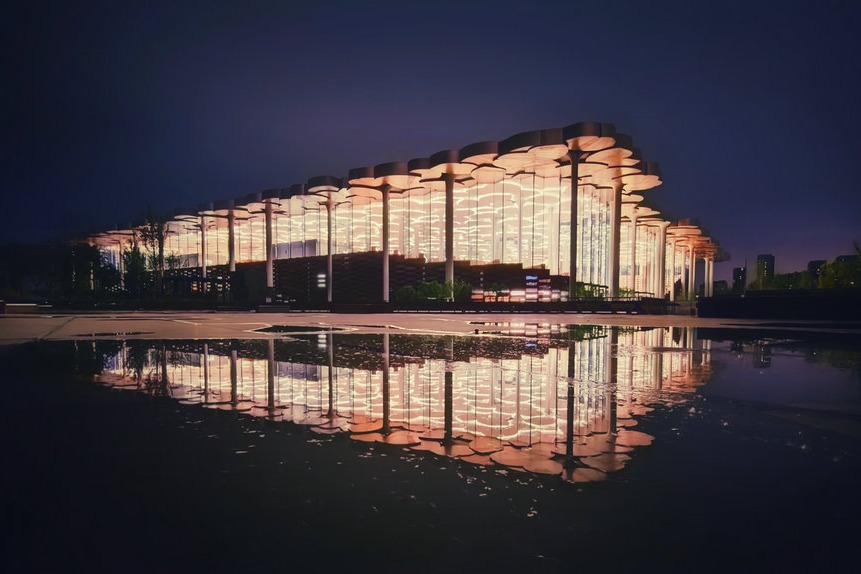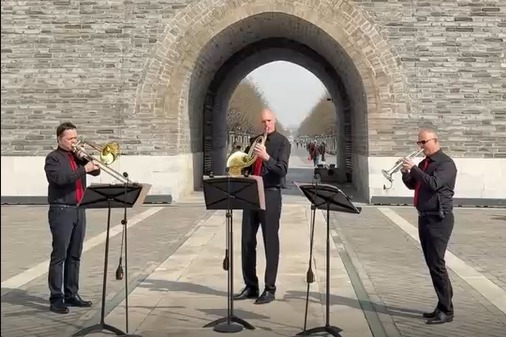Connecting the past with the future


The 12th-century monumental scroll painting Along the River During the Qingming Festival vividly showcases the cultural splendor and social prosperity of Bianjing (now Kaifeng, in Henan province), as the capital of the Northern Song Dynasty (960-1127). At the heart of this masterpiece lies the Hongqiao Bridge spanning the Bianhe River, resembling a vibrant rainbow teeming with bustling crowds.
Meticulous scrutiny by ancient practitioners of architecture reveals the intricate construction of the bridge, crafted using wooden sunmao (mortise-and-tenon) joints. However, these sophisticated building techniques seemed to fade into obscurity over time.
In the 1980s, scholars were delighted to discover bridges in the mountainous areas of Zhejiang and Fujian provinces, which have similar and more advanced wooden structures. Different from the Hongqiao Bridge, they are covered with eaves.
Wooden arch covered bridges were brought into the spotlight during the meeting of the Three-Year Action Plan for the Protection of Covered Bridges (2023-25) held in Pingnan county, Ningde, Fujian province, in October.
The plan was issued last year by the Publicity Department of the Communist Party of China Central Committee, the Ministry of Culture and Tourism and the National Cultural Heritage Administration to promote the protection, research and use of historical covered bridges.

According to the plan, covered bridges are an important category in China, distinguished by their distinctive structures often made of wood or stone. Seamlessly blending with mountainous terrain, water bodies, pastoral vistas, ancient villages and bustling streets, these bridges encapsulate the essence of public life, cultural heritage and nostalgia within the local community.
The meeting was held to examine the progress achieved since the plan's implementation, bringing together heritage professionals from 13 provinces and autonomous regions, where covered bridges are distributed, to introduce their experience and insights.
According to Guan Qiang, then deputy director of the National Cultural Heritage Administration, an ongoing survey of the distribution of covered bridges across the country has unveiled 1,820 covered bridges, the number of which may increase.
"As shown in the current data of the survey, some provinces which we believed didn't boast many covered bridges are found to have many more than anticipated. For example, Shanxi province found six more, Gansu province has 20 more, Chongqing 49, Hubei province 75 and Sichuan province 85. In this way, Sichuan becomes known as a province where covered bridges are vastly distributed," Guan says.
Across the country, 118 million yuan ($16.5 million) has been invested in restoring the bridges, covering 99 projects. So far, 70 have been completed, he adds.
Efforts have also been made to promote the use of these bridges so that they can be better protected, Guan says.
Some provinces have designed new travel routes themed on covered bridges, trying to integrate them into local tourist development. For example, Zhejiang province has planned travel routes themed on covered bridges, with Lishui and Wenzhou taking the lead.
They have included 40 bridges and hope to showcase the living conditions of mountain dwellers and the cultural atmosphere of the countryside through the routes, says Zheng Jianhua, deputy director of Zhejiang's cultural heritage bureau.
Such routes often combine covered bridges with local cultural features, such as Qingyuan county, Zhejiang province, which is known as the origin of artificially cultivated xianggu, or shiitake mushrooms, across the world. The routes combine xianggu culture with that of the bridges and show the lives of people who grow them.
"Covered bridges are part of residents' lives and culture. The travel routes lead people to experience the local culture, including the bridges," says Zhou Lijun, director of Pingnan county's culture, sports and tourism bureau.
WANG RU in Ningde, Fujian





































